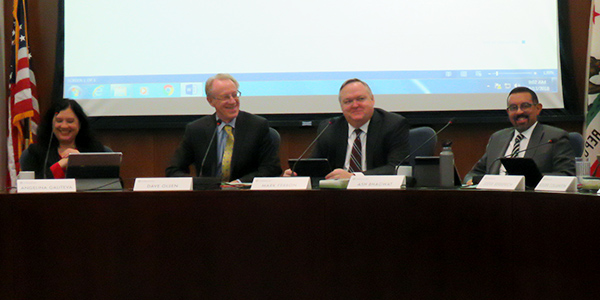By Hudson Sangree
FOLSOM, Calif. — CAISO’s 2019 revenue requirement will be less than this year’s, despite hiring and costs associated with its planned new role as reliability coordinator for most of the West, staff members told the ISO’s Board of Governors on Thursday.

CAISO’s Board of Governors met Thursday in Folsom, Calif., to vote on the 2019 budget and to hear updates on next year’s policy initiatives. | © RTO Insider
The ISO’s proposed revenue requirement for 2019 is $193.5 million — $3.7 million less than in 2019. That’s within “the tight range that the ISO has maintained over the past 13 budget cycles and beneath the FERC-approved cap of $202 million,” CFO Ryan Seghesio wrote in a memo to the board.
Total outlays will grow to $230.9 million from $217.4 million in 2018, but new revenues from the RC business as well as increased gains from the Western Energy Imbalance Market and other increased revenues will offset that spending rise by $7.2 million. A $13.5 million operating cost reserve adjustment for overcollection this year will provide an additional offset.

April Gordon, CAISO’s director of financial planning and procurement, briefed the ISO’s Board of Governors on the 2019 budget Thursday. | © RTO Insider
Operations and maintenance costs will rise by $10.5 million, April Gordon, director of financial planning and procurement, said at the board meeting. CAISO CEO Stephen Berberich added that the additional spending was primarily from “adding headcount” for the ISO’s new RC component.
The ISO is set to take over RC services from Peak Reliability for the bulk of Western Interconnection states, starting in California in July. (See RC Transition Fraught With Pitfalls, WECC Hears.)
CAISO’s telecommunication, outsourcing and contract costs also will increase in 2019 because of the RC transition, Gordon told the board.
Another cost driver is the expansion of the EIM, with new entities joining the market and increasing administrative expenses, Gordon said. Powerex and Idaho Power began trading in the EIM this year, and the Sacramento Municipal Utility District will join in April 2019, she noted. (See Idaho, Powerex Began Trading in Western EIM.)
The board unanimously passed the ISO’s 2019 budget proposal. It also heard about 2019’s policy initiatives from Greg Cook, CAISO’s director of market and infrastructure policy. A major effort involves proposed changes to the day-ahead market, including 15-minute scheduling and flexible ramping.

Greg Cook, director of market and infrastructure policy, outlined 2019’s policy initiatives at the CAISO Board of Governors meeting Thursday. | © RTO Insider
“We’re looking at significant enhancements to our day-ahead markets,” Cook said.
CAISO Governor Angelina Galiteva asked Cook whether ISO staff were aligning their policy initiatives with outside developments, particularly California’s adoption of a rule requiring all new homes to have rooftop solar panels starting in 2020. The state Building Standards Commission approved the rule, the first of its kind in the U.S., on Dec. 5.
“It may catch up with us before we even know what’s going on,” Galiteva said.
In addition to solar panels, many households will eventually get in-home electricity storage units, she said. “My sense is people are going to start installing storage and a lot of it,” she said.
Berberich responded, “Governor, I think you’re probably appropriately worried.” He said behind-the-meter storage, linked to home solar panels, would complicate CAISO’s forecasting.
“Storage is going to be the biggest issue for us to sort out,” the CEO said. Policies may be needed to govern the charging and discharging of storage units, including financial incentives for homeowners, he said.
“I’m not suggesting we send real-time prices to retail customers,” he said. “I’m not sure that works.”
But policymakers may need to “signal to the retail level as best we can,” he said. “Then you can shape the behavior and usage.”


